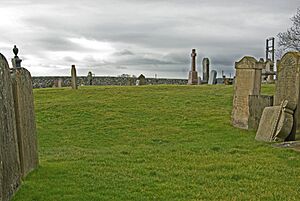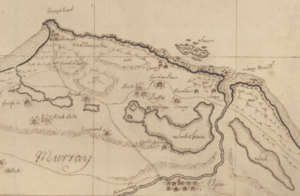Kinneddar facts for kids
Kinneddar Castle was once the home of the bishops of Moray in Moray, Scotland. It was used by the bishops from around 1187. The first bishop known to live there was Bishop Richard (1187–1203). Not much of the castle is left today, but the site is protected as a scheduled ancient monument, which means it's an important historical place.
Contents
What's in a Name?
The name Kinneddar comes from two old Gaelic words. Cenn means "head" or "end." Foithir likely comes from a Pictish word meaning "district" or "region." Even though foithir is Gaelic, it's only found in place names in eastern Scotland, where the Picts used to live. It often points to important areas. So, the name Kinneddar probably shows that it was a key place in a larger, important area, possibly linked to Burghead Fort.
Where is Kinneddar?
Kinneddar is on a raised piece of land that was once right next to Loch Spynie. The loch's marshy areas surrounded the site on three sides. In the Middle Ages, Loch Spynie was a sea loch, meaning it was connected to the sea. It stretched about 11 kilometers from Kinneddar west to Burghead. This provided a safe place for ships to anchor.
Even in 1207, Kinneddar was described as being "in a corner of the sea." However, by the 1600s, sand had blocked the loch from the sea, turning it into a freshwater loch. In the 1800s, much of the loch was drained to its smaller size today.
The sandstone ridge between Burghead and Lossiemouth was like an island long ago. It had several unique Pictish sites. Besides the religious site at Kinneddar, there was Burghead Fort, the largest fortified place in early Scottish history. There was also the Sculptor's Cave at Covesea, which was a special ritual spot for the Picts. This area was likely the most important center of royal power for the Pictish kingdom of Fortriu, which was powerful from the 300s to the 800s.
History of Kinneddar
An Ancient Pictish Site
Kinneddar was one of the main religious centers for the Picts. Scientists have used radiocarbon dating to show that people were active here from the 600s. The site was surrounded by large ditches, first dug in the 600s, enclosing an area of about 8.6 hectares. This was the largest such enclosure found in Northern Pictland.
Inside this area, there's proof of a busy settlement and industry. This includes a smithing hearth and signs of ironworking. There were also large wooden roundhouses. Smaller areas added to the south in the 1000s and 1100s suggest the site grew in size and importance over time. The size and layout of Kinneddar are very similar to Iona Abbey. This suggests Kinneddar might have been connected to the church of Columba.
Kinneddar is famous for a collection of carved Pictish stones. There are 32 fragments, including parts of ten cross-slabs, three free-standing crosses, and at least eight panels from stone shrine-chests. Some of these sculptures were unfinished, showing they were made right there. The stones have patterns like knotwork and ring-headed crosses. Some also show human figures, such as horse-riders and warriors with spears. One stone has a crescent and V-rod pattern.
A very important carving is a piece of a panel showing the biblical King David opening the jaws of a lion. This carving is similar to the more complete St Andrews Sarcophagus from St Andrews Cathedral. It likely held the body or important items of a king or saint. King David was a symbol of royal power. This shows that Kinneddar was a focus for royal support, possibly linked to the nearby Burghead Fort. The sculptures from Kinneddar are also similar to those found at Portmahomack. This suggests these two religious houses received most of the royal support in the kingdom of Fortriu.
The Pictish sculptures found near the castle and churchyard show that this area was an important Christian center in the 700s. It might have been a key place for the conversion of the Picts to Christianity.
Kinneddar Kirk (Church)
Within the area of the old religious site stood the ancient Kirk of Kinneddar. Between the 700s and 900s, at least two shrines were inside the church. These probably held one or more saint's relics (holy objects). One of these might have been a small chapel with a "stone bed" set up at Kinneddar by the early saint Gervadius, according to a 1500s book called the Aberdeen Breviary.
Kinneddar became the main church (cathedral) for the Diocese of Moray when Richard de Lincoln was Bishop of Moray between 1187 and 1203. This happened after the bishop's seat moved from Birnie. However, in 1207/8, the main church moved again to Spynie. Pope Innocent III confirmed Spynie as the cathedral of Moray.
Even though Kinneddar was no longer a cathedral, it remained important. Records show that the bishopric held important ceremonies there at least six times between 1226 and 1328. A church document was also signed there during the time of Bishop Alexander Bur (1362–1397). Gothic tracery (decorative stone work) was added to the church between 1252 and 1298, when Archibald was bishop. When the Bishop's Palace was no longer used, its tower became the church's belfry (bell tower).
The Kinneddar church area was joined with Ogstoun to form the new parish of Drainie on February 17, 1669. The Kinneddar church stopped being used in 1676. Stones from Kinneddar were then used to build the new church at Drainie. Although the church's foundations were still visible in 1760, by 1792, only "vestiges" (small traces) remained.
The Bishop's Palace
Bishop Archibald made the castle bigger or rebuilt it around 1280. The bishops continued to use it until the late 1300s. The palace was attacked and burned by Robert the Bruce and David de Moravia in 1308. But it was repaired and recorded as the home of Bishop Alexander Bur in 1383.
The palace remained the head of the barony (a type of land division) of Kinneddar until 1451. At that time, all nine baronies held by the Bishops of Moray were combined into one, with Spynie as its head. From 1462, Bishop David Stewart might have used stones from the now-unused Kinneddar palace to build the David Tower at Spynie Palace. By 1623, it was described as palatium dirutum, meaning the "ruined" or "destroyed" palace.
Today, nothing is left of the castle except one piece of a stone wall. This piece is now part of the Kinneddar kirkyard (churchyard) boundary wall. The ruined structure was still there in 1734. It was described as a central tower surrounded by two hexagonal (six-sided) walls. This made it very unique in Scotland.
Images for kids
-
The mercat cross of Kinneddar, standing in the old Kirkyard





